The Microsoft Surface Book 2 (15-Inch) Review: Second Time's The Charm
by Brett Howse on December 21, 2017 8:00 AM EST- Posted in
- Laptops
- Microsoft
- Surface
- Pascal
- Surface Book
- Kaby Lake Refresh
Battery Life
The original Surface Book we tested was the Core i5 model, and it offered amazing battery life that the Core i7 model with a discrete GPU couldn’t quite match. With the Surface Book 2 15, the battery capacity has increased, although so has the display size and resolution, so it’ll be interesting to see how that impacts the results.
Our battery life tests include our older 2013 web browsing test, a newer 2016 web browsing test which is more demanding, and a movie playback test. All of our browsing is done with Edge, and movie playback with the built-in Films and TV software, with the display set at 200 nits of brightness.
2013 Light
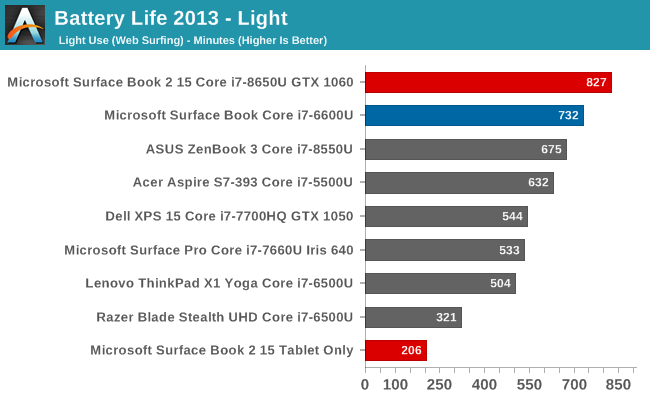
You feel kind of greedy when you feel like almost 14 hours of browsing isn’t enough, but it felt like the Surface Book 2 might really set a new record with the large 85 Wh of battery capacity. The new model handily outperforms the outgoing Surface Book Core i7 though, despite the larger display and higher resolution.
The tablet itself will still get several hours away from the base, which is more than enough time for the use case of the tablet, which is going to be for short sessions away from the base.
2016 Web
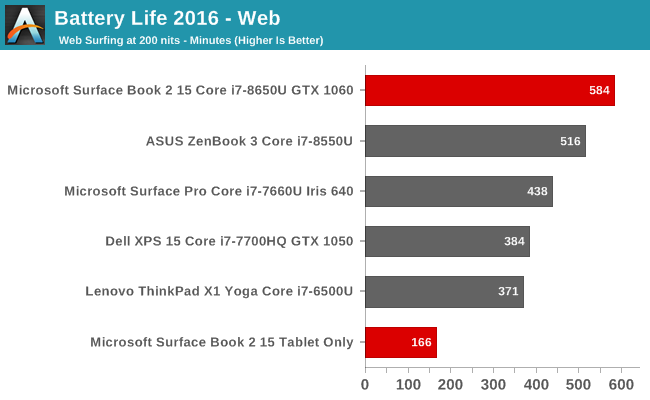
Our newer web test is more demanding of the CPU, and on devices like the Surface Book 2, where the CPU power usage is a significant factor in the overall power drain, the result is less battery life than our older, easier test. At almost ten hours of battery life though, the Surface Book 2 still offers a lot of time off the mains.
Normalized Results

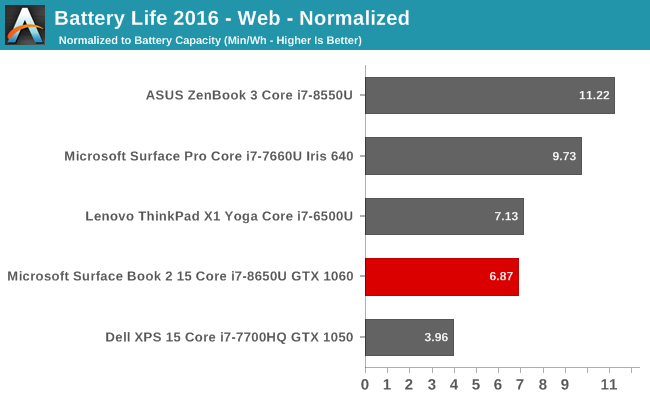
By removing the battery capacity from the equation, we can see the efficiency of each device. Here, the larger battery size is removed, and the Surface Book 2 ends up about midfield. The larger display and higher resolution of the display are a significant impact on the battery life.
To dig in to this a bit more, additional testing was done to see just how much power the display draws. At maximum brightness, and with the system at idle, the display draws 7.65 W of power, while the rest of the system only consumes 1.43 W of power. On our 200 nit display brightness setting, that power requirement of the display drops to 4.1 W, which is still over double what the rest of the system is using at idle. The display is a significant factor, as expected.
Movie Playback
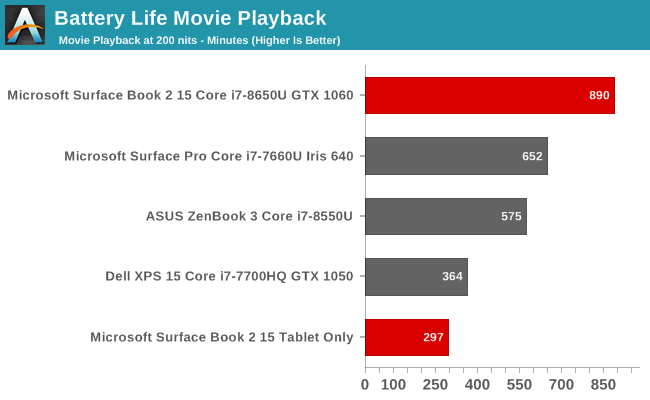

When playing back a movie, the CPU can offload the task to fixed function hardware, so the overall power usage goes down even further than normal. The Surface Book 2 offers tremendous battery life at this task, coming in at close to 15 hours.
This would let you play The Avengers over six times on a single charge. That should be enough for almost any scenario.
With just the tablet, the battery life is still almost five hours of movie playback, which is certainly usable, although I doubt most people would use just the tablet to watch movies due to the size of it.
Charge Time
Despite the larger battery, the 100-Watt AC Adapter charges the battery quite quickly, and both batteries are full in under three hours.
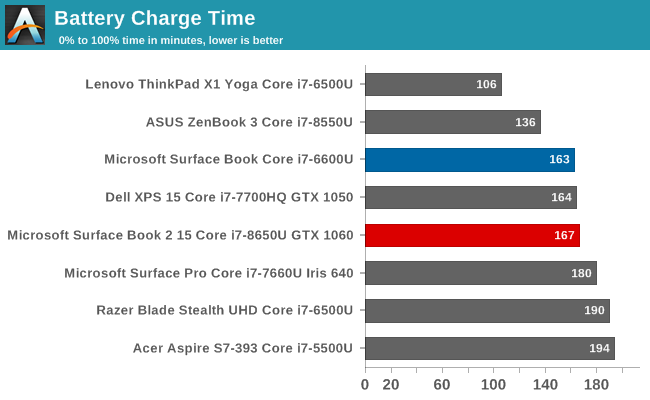
Both batteries charge at the same time, and are almost in lock-step with each other in terms of charge, despite the difference in capacity.
For those interested, the bottom of the tablet features the same Surface Connect port, so you can charge the tablet away from the base if necessary, although most of the time it would be charged when docked.


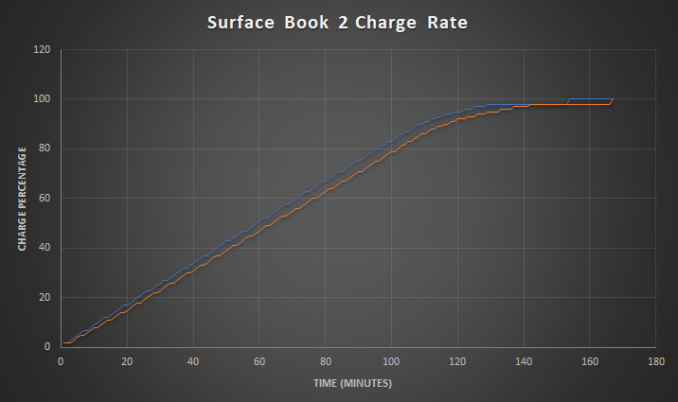








120 Comments
View All Comments
edgineer - Thursday, December 21, 2017 - link
>the lack of Thunderbolt 3 deprives the owner of the ability to output dual UHD video feedsWait, are you sure Thunderbolt 3 is the actual reason for that? MS' support site says only one UHD@60Hz output is possible, sure.
But when the XPS 15's only-2-PCIe-lanes brewhaha happened, reviewers explained that the DisplayPort-alternate mode bandwidth is NOT affected by Thunderbolt 3. Only eGPU capability is changed by TB3 status, and not external display capability. Or is it not?
The only other clues I have are that MS' support says external display capability is limited by the CPU. Intel's ARK page for the 8650u lists basically the exact DP capabilities that MS gave, except that the chip should support 3 displays, and the caveat "Please check with the system vendor to determine if your system delivers this feature." This makes me think that the limitation lies with the specific (lack of) implementation of CPU capabilities, and that having the TB3 chip installed doesn't change this.
Reflex - Thursday, December 21, 2017 - link
Your analysis is correct, TB is just another alternate mode for USB-C and does not impact the number of displays supported. There is something else going on there.Brett Howse - Thursday, December 21, 2017 - link
That's not the case at all. DisplayPort only has enough bandwidth for a single UHD feed at 60 FPS. You can't drive 2 UHD monitors on USB-C without the extra bandwidth provided by Thunderbolt 3.Brett Howse - Thursday, December 21, 2017 - link
I guess I also need to point out USB-C video mode only supports a single DisplayPort 1.2 (usually - other specs can work on short cables) which is why you can only get 1 UHD at 60 Hz with no compression.Reflex - Thursday, December 21, 2017 - link
Thanks for the correction I was not aware of that.imaheadcase - Thursday, December 21, 2017 - link
For the price points they are at, i cant help but think the screen is %99 of the cost of this thing, Not he GPUGalcobar - Thursday, December 21, 2017 - link
If power consumption is a concern, then there's a conundrum: is it better to have an older (6th or 7th gen) processor paired with DDR3L, or an 8th gen processor paired with DDR4?Assume same processor TDP across generations.
Brett Howse - Thursday, December 21, 2017 - link
If power consumption is a concern then the best option is LPDDR3 at the moment on the PC side.Galcobar - Friday, December 22, 2017 - link
Thank you for the prompt reply.I've become the person in the office people consult when buying their new laptops, and I've noticed the available configurations now span the seventh and eighth gen Intel Cores. Since we don't run anything that really stresses the CPU, the extra cores of the 8th gen are interesting only if they improve efficiency. If the reduction in activity gains less battery life than the switch from LPDDR3 to DDR4 costs, I'll keep advising people to go with the 7th gen options.
Galcobar - Saturday, December 23, 2017 - link
Just came across - or re-discovered - the 2015 article on the 6th gen processors https://www.anandtech.com/show/9483/intel-skylake-...It states that DDR4 runs at 1.2V or 1.5V.
That would make it more efficient than LPDDR3's 1.35/1.5V, would it not?